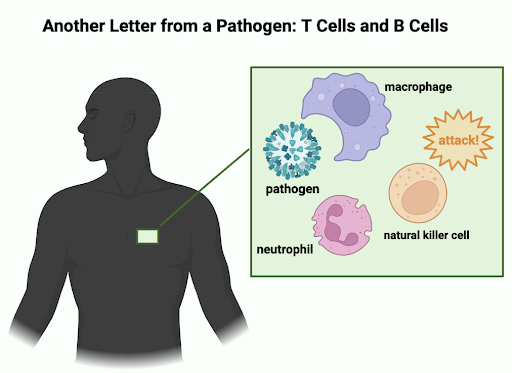Another Letter from a Pathogen: Neutrophil & Macrophages
By Ariane Tsai, C2ST Intern, University of Illinois Urbana-Champaign, Institute for Genomic Biology
In a recent blog post, we looked at adaptive immunity and how T cells and B cells react to seeing a pathogen in our bodies. But T cells and B cells are not the only immune cells fighting against outside invaders. In this post, we will look at other formidable, innate immune cells and learn how they protect our bodies as first responders!

Dear Reader,
You may have seen a letter from my colleague recently. They described their journey into the human body, which ultimately ended in their demise. Inspired by their storytelling, I have decided to tell my story here as well.
Like the other pathogen, I encountered a human body one day. My goal was to infect other cells so that they would become like me. I knew that the only way I could do that was if I avoided all the immune cells successfully. I tried to disguise myself to look like I was native to the body, and I was able to get by for a while. It all started to go wrong when I was spotted by a group of white blood cells* called neutrophils.
Now there are only three rules in the neutrophil playbook: (1) kill harmful microbes*, (2) protect the body at all costs, (3) when in doubt, see Rule #1. Despite my best hiding efforts, the neutrophils saw me as a threat and launched a powerful attack by unleashing antimicrobial chemicals that they had stored in their cell bodies. They also enacted Rule #2 when they sacrificed themselves through a process called NETosis. Neutrophils undergo NETosis by dying (on purpose) in order to release high concentrations of antimicrobial chemicals.
And if you think this is not enough, the macrophages* were also at the scene to eat and destroy! If you have not seen a macrophage before, I very much envy you. The sheer size of them made me drop to my knees. They began to engulf and digest me. I knew this was the end. Between the efforts of the neutrophils and macrophages, I accepted my fate and succumbed to my death.
Even though I did not survive in the human body for very long, I still put up a good fight. Look on the bright side; since I didn’t stay in the body long enough to invade a healthy cell, I did not encounter any natural killer (NK) cells. Infected cells like to send distress calls to NK cells, which often results in the NK cells ordering the infected cell to self-destruct (“apoptosis”) to stop me. So, at the end of the day, I am proud of myself for going through this treacherous journey. After all, it is the effort that counts, right?
*Microbes: also known as microorganisms. Some common ones are bacteria, viruses, and fungi.
*White blood cells: also known as leukocytes. They are a type of blood cell made in the bone marrow that plays an essential role in the immune system.
*Macrophage: an innate immune cell that protects the body by engulfing and digesting pathogens (“phagocytosis”). They also play a huge role in tissue repair after injury.
For a much deeper reading on the innate immune system, check out: Neutrophil Function: From Mechanisms to Disease and Exploring the full spectrum of macrophage activation